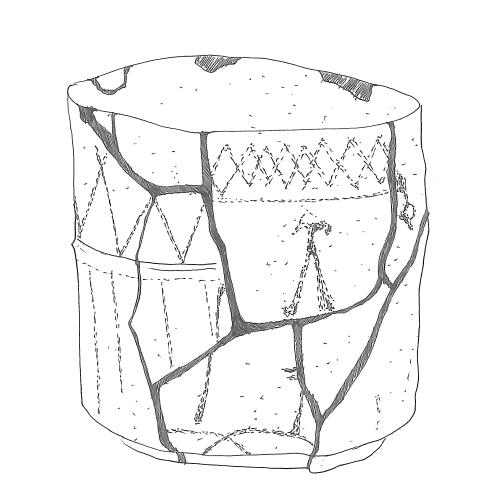Japanese Potteries(Explanations to the technical terms of ceramics No.12)
There are various technical words on potteries. Here are some of those, for which I'd like to give you some remarks.
kintsugi
One day, you've broken your favorite dish from carelessness. Then, do you just throw it away? Even though it looks like useless, isn't it frustrating to just give it up and throw away because you feel like throwing your memories together?TOKYO NATIONAL MUSEUM Celadon glazed tea bowl, known as "Bakohan".
This beautiful work is a celadon-glazed tea bowl called “Bakohan E Do you see that some metal parts are mounted in its body? It was owned by a tycoon and got cracked in the course of use. To his inquiry to order the same bowl, his Chinese counterpart as its origin replied that there's nothing as beautiful as this one and returned the same that was fixed with steel hooks. The tycoon who thought to replace it with new one was made aware that the one he had was something so precious that couldn't be replaced.
SEKISUI MUSEUM "Yokubukuro"
This rustic one shaped like a vase is called mizusashi (pitcher), a tea ceremony tool, which has a big crack from its middle part to the bottom that is covered by a gold pattern on the black ground. Its producer is Kawakita Handeishi. It was made based on a work named “Yaburebukuro E(which literally means a broken vessel) produced in the early 17th century. “Yaburebukuro Eought to be broken and unusable in its original meaning, but it was repaired, and its large crack attracted tea ceremony masters in those time. Kawakita Handeishi, also as one who had been in touch with that mind, produced a similar pitcher and named it as “Yokubukuro Emaking a burlesque of “Yaburebukuro E
"Gojusantsugi"

Drawing by Naoki Kato
Doesn't this teacup look strange? Look at the patterns. The each connected parts are totally different in their patterns. The teacup, named as “Gojusantsugi E(which literally means 53 parts connected), is a single work that consists of 20 broken pieces or so. I don't know if I can say that it was repaired, but the work to this extent seems to make each broken piece happy.
All what you've seen now are called “kintsugi E (To be exact, the Bakohan is not really one of kintsugis as it's with steel parts, and the Gojusantsugi is made by a technique of “yobitsugi E However, I'm giving explanation here collectively in the same way.) Whichever one is chipped or cracked, and fixed in an eye-catching way. I think here may be an idea that is based on the Buddhism's view of life and death. What has been broken ought to be once lost from this world. However, it is supposed to demonstrate the mind to think back what it was in the previous life and try to be better in this life if there were a cycle of reincarnation.
The Bakohan was named after the appearance of locusts on top of a horse using the cramps as locusts. The Yokubukuro gave a pitcher humor and scenery by the pattern representing water called Seikaiha that was drawn on the cracked part. The Gojusantsugi infused new life into the interesting look of yobitsugi by coupling the number of sightseeing spots along the Tokaido road as the origin of its name. Thus, by furnishing potteries with new charms and keeping on using, their attractions would be going to further increase.
Then, how is the kintsugi made? Now I explain how to repair potteries. For both of the Yokubukuro and the Gojusantsugi, urushi (lacquer tree sap) was used for the repair. Lacquer has its characteristic of getting hard when it's dried while it is often used as paint. Therefore, in Japan, they have used lacquer when creating Buddha images. When pasting broken pieces each other, apply some lacquer in between the pieces and dry it. If the gap is large like the Yokubukuro, immerse some paper or cloth in lacquer and put it in the gap, and then apply some more lacquer on the surface over and over to make it thick to a certain extent. It may sound like very easy, but you will get a rash from lacquer easily, and if your skin is sensitive, even its smell may make you feel itchy. You must handle it with the utmost care together with someone who has proper knowledge.
Lacquer has its special nature to become dry if humidity is high. The workmen use a room called “muro Ethat is like a large steamer to make it dry, but usually you don't have such a room.
So alternatively you can use artificial lacquer or putty instead of lacquer tree sap that becomes dry easily. If you use putty, there's no trouble as you can use it in the way like you fulfill large gaps with clay. In the case of using lacquer, they create flashiness with inlaying gold dust on the surface or make splendid decoration just like the Yokubukuro, but it costs you a lot. To make it with a lower cost, you apply artificial lacquer in which some brass powder is mixed which may look like gold. Artificial lacquer is water resistant as it is often used for fishing tackles, so it won't come out even if you wash it. If it doesn't have to be in gold color, you can preferably make it so colorful like a fishing float or lure. By using a little time and effort in repairing, your pottery will be more unique and your affection to it must become stronger. (By the way, the one repaired in whichever way can't be put in a microwave oven.)
